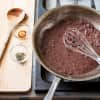Why Cold Butter Keeps Sauces from Breaking
Classic French cookbooks call for slowly whisking in cold pieces of butter, a little at a time. We wanted to confirm if this is really necessary.
Many home cooks are intimidated by classic butter sauces like beurre blanc because they are notoriously finicky preparations; the high butter content means that the sauces have a tendency to break. Classic French cookbooks call for slowly whisking in cold pieces of butter, a little at a time. We wanted to confirm if this is really necessary. We set out to answer two questions: Does the temperature of butter matter? And does it need to be added incrementally, or can it be whisked in all at once? Before we got to work, we needed to review a few points about butter.
Unlike oils, which are 100 percent fat, butter is an emulsion of water in butterfat (16 to 18 percent water to 80 percent butterfat). It’s known as a water-in-fat emulsion because the water is dispersed in tiny droplets throughout the fat. But when butter is whisked into a small amount of liquid, as happens when making a butter sauce, the butter inverts to a fat-in-water emulsion. You can easily taste the difference: We perceive butter as being fatty and greasy because the fat coats all the water and makes direct contact with our tongues. In a butter sauce, we notice plenty of richness, but it doesn’t taste greasy, thanks to the thin coating of liquid surrounding the fat. This ability to convert from one type of emulsion to the other is what allows such a large amount of butter to turn into a sauce; if you swapped in oil for the butter, the oil would immediately separate and float on the top of the liquid.
EXPERIMENT: We made several batches of a white butter sauce that calls for 8 tablespoons of butter. We tested whisking the butter into a wine and vinegar base, one tablespoon at a time, both softened at room temperature and cold from the fridge. We also tested whisking in the butter, cut into four 2-tablespoon pieces, all at once. We tested this approach twice as well, with cold and then softened butter.
RESULTS: The only sample that thickened into a proper butter sauce was the one made by whisking in cold butter one tablespoon at a time. The other sauces remained thin and broke. Why the difference?
EXPLANATION: Cold butter melts slowly, which allows you to thoroughly break the butterfat into tiny droplets that can be dispersed throughout the water. And gradually adding the butter one piece at a time slows down the process even further. Together, these steps ensure a stable emulsion. If you add the fat warm and/or too quickly, the fat will end up as larger droplets, which translates to a weaker emulsion (and thinner sauce) that is more prone to break. So tradition has it right. For a successfully thickened butter sauce, make sure to start with cold butter cut into small pieces, add it gradually, and whisk constantly.



